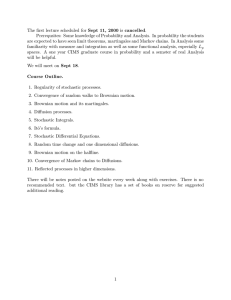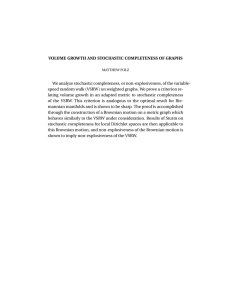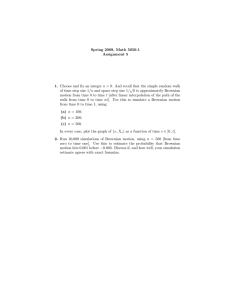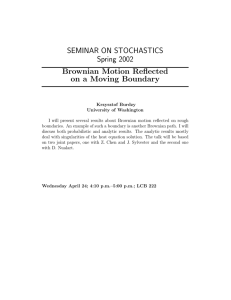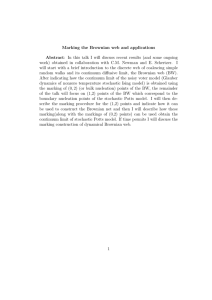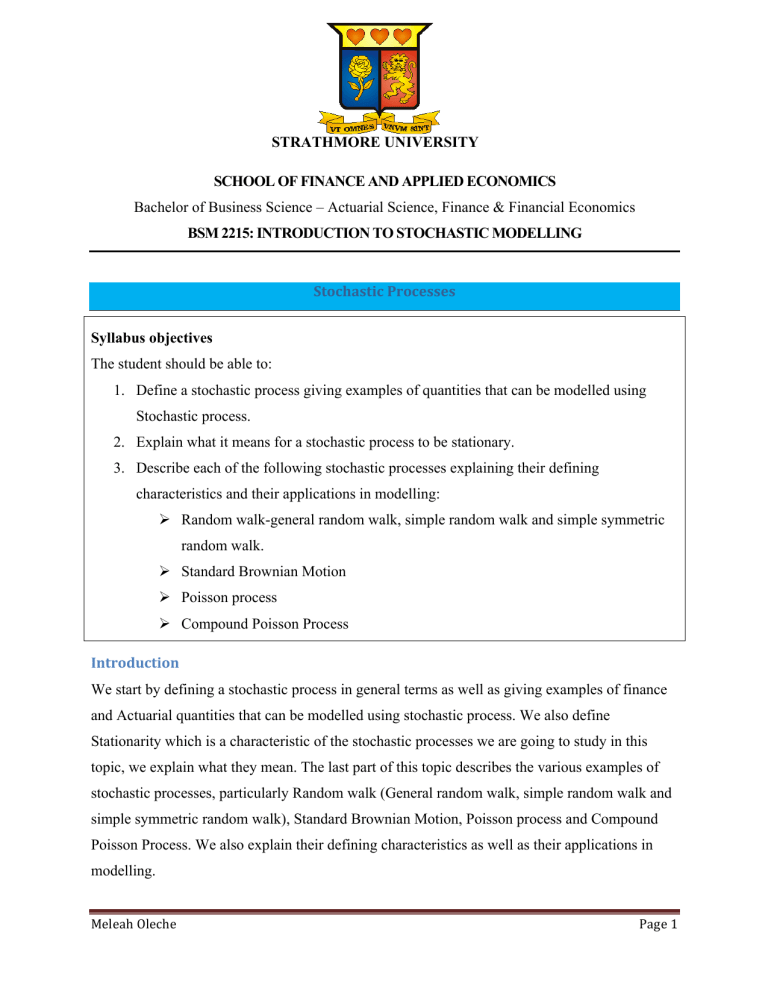
STRATHMORE UNIVERSITY
SCHOOL OF FINANCE AND APPLIED ECONOMICS
Bachelor of Business Science – Actuarial Science, Finance & Financial Economics
BSM 2215: INTRODUCTION TO STOCHASTIC MODELLING
Stochastic Processes
Syllabus objectives
The student should be able to:
1. Define a stochastic process giving examples of quantities that can be modelled using
Stochastic process.
2. Explain what it means for a stochastic process to be stationary.
3. Describe each of the following stochastic processes explaining their defining
characteristics and their applications in modelling:
Ø Random walk-general random walk, simple random walk and simple symmetric
random walk.
Ø Standard Brownian Motion
Ø Poisson process
Ø Compound Poisson Process
Introduction
We start by defining a stochastic process in general terms as well as giving examples of finance
and Actuarial quantities that can be modelled using stochastic process. We also define
Stationarity which is a characteristic of the stochastic processes we are going to study in this
topic, we explain what they mean. The last part of this topic describes the various examples of
stochastic processes, particularly Random walk (General random walk, simple random walk and
simple symmetric random walk), Standard Brownian Motion, Poisson process and Compound
Poisson Process. We also explain their defining characteristics as well as their applications in
modelling.
Meleah Oleche
Page 1
Definition of a Stochastic Process
It is sequence of values of some quantity in which the future values cannot be predicted with
certainty. For instance Let the current (at 𝐭 = 𝟎) price of a share price be 𝐒𝟎 . At time 𝐭 = 𝟏 , this
price could go up to a random price 𝐒𝐮 or go down to a random price 𝐒𝐝 or even stay at the
current price 𝐒𝟎 .The price of the share is therefore a stochastic process because it represents a
sequence of values in which future values cannot be predicted with certainty.
Stationarity
A stochastic process X is said to be Stationary if the distribution X)* +, and X)- +, are identical.
i.e. their statistical properties remain unchanged (variance, mean e.t.c.) as time elapses. The
statistical properties only depend on the time lag.
Random walk
Let 𝑋/ , 𝑋0 …𝑋1 be a sequence of independent, identically distributed discrete random variables.
Define 𝑆3 = 𝑋/ + 𝑋0 + ⋯ + 𝑋3 with the initial condition e 𝑆6 = 0. The sequence 𝑆3 is called a
general random walk.
Simple random walk
In a special case where the steps 𝑋8 ′𝑠 can only take values of either +1 or -1, the process is
known as simple random walk.
Simple symmetric Random walk
In more special case where the the values of the steps can be +1 or -1 with equal probabilities
(0.5). I.e.
𝑋8 =
+1 𝑤𝑖𝑡ℎ 𝑎 𝑝𝑟𝑜𝑏𝑎𝑏𝑖𝑙𝑖𝑡𝑦 𝑜𝑓 0.5
−1 𝑤𝑖𝑡ℎ 𝑎 𝑝𝑟𝑜𝑏𝑎𝑏𝑖𝑙𝑖𝑡𝑦 𝑜𝑓 0.5
such a process is called simple symmetric random walk.
It is equally likely to step upwards or downwards.
Standard Brownian Motion
Standard Brownian Motion can be viewed as the continuous version of the simple symmetric
random walk. If we reduce the size of the step progressively from 1 unit until it is infinitesimal,
the simple symmetric random walk becomes a standard Brownian motion.
Meleah Oleche
Page 2
Definition of a standard Brownian Motion
A continuous stochastic process 𝑊M is a standard Brownian Motion if it has the following
defining characteristics:
Ø The initial value is zero i.e. 𝑊6 = 0
Ø It has independent increments i.e. for 𝑢 < 𝑠 < 𝑡, 𝑊M − 𝑊P does not depend on 𝑊Q .
Ø It has Gaussian(Normally distributed) increments i.e. 𝑊M − 𝑊P ~𝑁(0, 𝑡 − 𝑠)
Ø It has stationary increments i.e. the distribution of 𝑊M − 𝑊P only depend on the time lag
𝑡−𝑠
Ø 𝑊M has a continuous sample path i.e. 𝑊M is a continuous function of time, 𝑡 → 𝑊M
Remark: For 𝑠 < 𝑡 𝑊M can be decomposed as 𝑊M = 𝑊P + 𝑊M − 𝑊P
Other Properties of standard Brownian Motion
Rescaling Property
If 𝑊M is a standard Brownian motion and c is a positive constant, then the rescaled process
/
𝑊 ∗ M = 𝑊YM is also a standard Brownian Motion.
Y
Proof:
1
1
𝑊YM = 𝐸 𝑊YM = 0
𝑐
𝑐
1
1
1
𝑉𝑎𝑟 𝑊YM = 0 𝑉𝑎𝑟 𝑊YM = 0 ×𝑐𝑡 = 𝑡
𝑐
𝑐
𝑐
𝐸
Time-inversion property
If 𝑊M is a standard Brownian motion and c is a positive constant, then the rescaled process
𝑊 ∗ M = 𝑡𝑊* is also a standard Brownian Motion.
^
Proof:
1
𝐸 𝑡𝑊/ = 𝐸 𝑊/ = 0
𝑐
M
M
1
𝑉𝑎𝑟 𝑡𝑊/ = 𝑡 0 𝑉𝑎𝑟 𝑊/ = 𝑡 0 × = 𝑡
𝑡
M
M
Meleah Oleche
Page 3
𝐶𝑜𝑣 𝑊M , 𝑊P = 𝑚𝑖𝑛 (𝑠, 𝑡)
Proof:
𝐶𝑜𝑣 𝑊M , 𝑊P = 𝐶𝑜𝑣 𝑊P + 𝑊M − 𝑊P , 𝑊P = 𝐶𝑜𝑣 𝑊P , 𝑊P + 𝐶𝑜𝑣 𝑊M − 𝑊P , 𝑊P
𝐶𝑜𝑣 𝑊P , 𝑊P = 𝑠 = min (𝑠, 𝑡)
Applications of Standard Brownian Motion
Standard motion is rarely used to model anything directly. A standard Brownian motion is
certain to become negative eventually. That means that it cannot be used to model the share
prices, for example, since we do not expect the share prices to be negative. However, it forms
the key building block for most continuous-time stochastic models which are modelled as
diffusion (Ito processes). Examples of these are Geometric Brownian motion (used to model
share prices) and Ornstein-Uhlenbeck (used to model interest rates). Some martingales are
constructed from standard Brownian motion. Martingales are useful in the pricing and hedging
of financial derivative.
Poisson process
An integer-valued process 𝐍𝐭 with intensity 𝛌 is called a Poisson process if it has the following
properties:
Ø 𝑁6 = 0
Ø 𝑁M has independent increments
Ø 𝑁M has Poisson distributed increments with intensity 𝜆(𝑡 − 𝑠). I.e.
[𝜆 𝑡 − 𝑠 ]3 𝑒 mn(MmP)
𝑃 𝑁M − 𝑁P = 𝑛 =
𝑛!
Meleah Oleche
Page 4
Proposition:
Let N be a Poisson process with intensity 𝜆, then the increments have the following moment
generating function:
𝑀q^ mqr (𝑟) = 𝐸 𝑒 s(q^ mqr ) = 𝑒 [n
MmP t u m/ ]
The Poisson process is known as a counting process because it can be used in counting the
occurrence of events for instance claim in insurance company, car accident and arrival of
customers at a service point.
Compound Poisson
The Poisson process alone is inadequate in modelling, for instance it can only count the number
of claims but no information on the amounts/size of claims. However, the insurance company is
interested in both the number and size of the claims. Let 𝑋8 denote independent identically
distributed claim sizes. We also assume further that 𝑋8 are independent on 𝑁M . We can then
define a compound process S as follows:
𝑆M = 𝑋/ + 𝑋0 + ⋯ + 𝑋q^
Remark: A compound Poisson process has independent and stationary increments too.
Meleah Oleche
Page 5
Proposition:
The Moment generating function(MGF) of the increment of a compound Poisson process
𝑆M − 𝑆P is given by:
𝑀v^ mvr 𝑟 = 𝐸 𝑒 s
v^ mvr
= 𝑀q^wr ln 𝑀y 𝑟
= 𝑒 [n
MmP z{ (s)m/ ]
Proof:
𝑀v^ mvr 𝑟 = 𝐸 𝑒 s
= 𝐸 𝐸 𝑒s
~^wr
}€* y}
|𝑁MmP
v^ mvr
=𝐸 𝑒
~^wr
}€* y}
= 𝐸 𝐸 𝑒s
~
s ~^ | }
r•*
|𝑁MmP
= 𝐸[𝑒 s
~^wr
}€* |}
]
= 𝐸 𝐸 𝑒 sy* +sy- +⋯+sy~^wr
𝐸 𝐸 𝑒 sy* 𝐸 𝑒 sy* 𝐸 𝑒 sy- …×𝐸 𝑒 sy~^wr
𝐸 𝑀y (𝑟)×𝑀y (𝑟)× …×𝑀y (𝑟) = 𝐸[ 𝑀y 𝑟
𝐸
𝑀y 𝑟
q^wr
= 𝐸 𝑒 ƒ„
z{ s
~^wr
= 𝑒 [n
Meleah Oleche
q^wr
]
= 𝐸 𝑒 q^wr ƒ„ z{ (s) = 𝑀q^wr (ln 𝑀y (𝑟))
MmP z{ (s)m/ ]
Page 6


